Plasmonic Nanosensors and Metasensors Based on New Physical Mechanisms
Abstract
:1. Introduction
2. Parameters of Plasmonic Sensors
2.1. Quality Factor
2.2. Sensitivity and Figure of Merit
2.3. Limit of Detection
3. Fano Resonance–Based Sensors
3.1. The Theory of Fano Resonance
3.2. Fano Structure and Fano Resonance–Based Sensors
3.2.1. Single Metal Nanoparticles
3.2.2. Coupled Fano Resonance Structures and Sensors
Symmetric Broken Metal Nanostructures
Fano Resonance and Sensors Based on Metal Nanoparticle Polymers
Fano Resonance and Sensors Based on Nanoarray and Metasurfaces
Fano Resonance and Sensors Based on Grating and Metal–Insulator–Metal Structures
Fano Sensors Based on Single Resonant Structures
3.2.3. Fano Resonance Based on Nanoporous Gold and Its Sensing Applications
4. Exceptional Point
4.1. Theory of Exceptional Point
4.1.1. Design of EP Resonator
4.1.2. Improved Sensing Performance of EP Sensors
4.2. Development of EP and Sensors Based on EP
4.2.1. Exceptional Point in Passive Systems
4.2.2. Exceptional Surface
4.2.3. Active EP
5. Outlook of Fano and EP Sensors
5.1. Fano Sensors
5.2. EP Sensors
6. Conclusions
Author Contributions
Funding
Institutional Review Board Statement
Informed Consent Statement
Data Availability Statement
Conflicts of Interest
References
- Brongersma, M.L.; Shalaev, V.M. The Case for Plasmonics. Science 2010, 328, 440–441. [Google Scholar] [CrossRef] [PubMed]
- Kelly, K.L.; Coronado, E.; Zhao, L.L.; Schatz, G.C. The Optical Properties of Metal Nanoparticles: The Influence of Size, Shape, and Dielectric Environment. J. Phys. Chem. B 2003, 107, 668–677. [Google Scholar] [CrossRef]
- Li, W.; Camargo, P.; Lu, X.; Xia, Y. Dimers of Silver Nanospheres: Facile Synthesis and Their Use as Hot Spots for Surface–Enhanced Raman Scattering. Nano Lett. 2008, 9, 485–490. [Google Scholar] [CrossRef]
- Nie, S.; Emory, S.R. Probing Single Molecules and Single Nanoparticles by Surface–Enhanced Raman Scattering. Science 1997, 275, 1102–1106. [Google Scholar] [CrossRef] [PubMed]
- Anker, J.N.; Hall, W.P.; Lyandres, O.; Shah, N.C.; Zhao, J.; Van Duyne, R.P. Biosensing with plasmonic nanosensors. Nature materials 2008, 7, 442–453. [Google Scholar] [CrossRef] [PubMed]
- Liu, N.; Weiss, T.; Mesch, M.; Langguth, L.; Eigenthaler, U.; Hirscher, M.; Sönnichsen, C.; Giessen, H. Planar Metamaterial Analogue of Electromagnetically Induced Transparency for Plasmonic Sensing. Nano Lett. 2009, 10, 1103–1107. [Google Scholar] [CrossRef] [PubMed]
- Kazuma, E.; Tatsuma, T. Localized surface plasmon resonance sensors based on wavelength–tunable spectral dips. Nanoscale 2013, 6, 2397–2405. [Google Scholar] [CrossRef]
- Chang, C.-Y.; Lin, H.-T.; Lai, M.-S.; Shieh, T.-Y.; Peng, C.-C.; Shih, M.-H.; Tung, Y.-C. Flexible Localized Surface Plasmon Resonance Sensor with Metal–Insulator–Metal Nanodisks on PDMS Substrate. Sci. Rep. 2018, 8, 11812. [Google Scholar] [CrossRef]
- Li, G.; Wang, Z.; Mao, X.; Zhang, Y.; Huo, X.; Liu, H.; Xu, S. Real–Time Two–Dimensional Mapping of Relative Local Surface Temperatures with a Thin–Film Sensor Array. Sensors 2016, 16, 977. [Google Scholar] [CrossRef]
- Lee, C.; Lawrie, B.; Pooser, R.; Lee, K.-G.; Rockstuhl, C.; Tame, M. Quantum Plasmonic Sensors. Chem. Rev. 2021, 121, 4743–4804. [Google Scholar] [CrossRef] [PubMed]
- Salomon, L.; Bassou, G.; Aourag, H.; Dufour, J.P.; de Fornel, F.; Carcenac, F.; Zayats, A.V. Local excitation of surface plasmon polaritons at discontinuities of a metal film: Theoretical analysis and optical near–field measurements. Phys. Rev. B 2002, 65, 125409. [Google Scholar] [CrossRef]
- Caballero, B.; García–Martín, A.; Cuevas, J.C. Hybrid Magnetoplasmonic Crystals Boost the Performance of Nanohole Arrays as Plasmonic Sensors. ACS Photonics 2016, 3, 203–208. [Google Scholar] [CrossRef]
- Diaz–Valencia, B.F.; Mejía–Salazar, J.R.; Oliveira, J.O.N.; Porras–Montenegro, N.; Albella, P. Enhanced Transverse Magneto–Optical Kerr Effect in Magnetoplasmonic Crystals for the Design of Highly Sensitive Plasmonic (Bio)sensing Platforms. ACS Omega 2017, 2, 7682–7685. [Google Scholar] [CrossRef] [PubMed]
- Vassant, S.; Archambault, A.; Marquier, F.; Pardo, F.; Gennser, U.; Cavanna, A.; Pelouard, J.-L.; Greffet, J.-J. Epsilon–Near–Zero Mode for Active Optoelectronic Devices. Phys. Rev. Lett. 2012, 109, 237401. [Google Scholar] [CrossRef]
- Traviss, D.; Bruck, R.; Mills, B.; Abb, M.; Muskens, O. Ultrafast plasmonics using transparent conductive oxide hybrids in the epsilon–near–zero regime. Appl. Phys. Lett. 2013, 102, 121112. [Google Scholar] [CrossRef]
- Padilla, W.J.; Basov, D.N.; Smith, D.R. Negative refractive index metamaterials. Mater. Today 2006, 9, 28–35. [Google Scholar] [CrossRef]
- Smith, D.R.; Pendry, J.B.; Wiltshire, M.C.K. Metamaterials and Negative Refractive Index. Science 2004, 305, 788–792. [Google Scholar] [CrossRef] [PubMed]
- Rasad, A.; Yudistira, H.T.; Qalbina, F.; Saputro, A.G.; Faisal, A. Multilayer flexible metamaterials based on circular shape with negative refractive index at microwave spectrum. Sens. Actuators A Phys. 2021, 332, 113208. [Google Scholar] [CrossRef]
- Abdulkarim, Y.I.; Deng, L.; Luo, H.; Huang, S.; Karaaslan, M.; Altıntaş, O.; Bakır, M.; Muhammadsharif, F.F.; N. Awl, H.; Sabah, C.; et al. Design and study of a metamaterial based sensor for the application of liquid chemicals detection. J. Mater. Res. Technol. 2020, 9, 10291–10304. [Google Scholar] [CrossRef]
- Karawdeniya, B.I.; Damry, A.M.; Murugappan, K.; Manjunath, S.; Bandara, Y.M.N.D.Y.; Jackson, C.J.; Tricoli, A.; Neshev, D. Surface Functionalization and Texturing of Optical Metasurfaces for Sensing Applications. Chem. Rev. 2022, 107, 2411–2502. [Google Scholar] [CrossRef] [PubMed]
- Miroshnichenko, A.E.; Flach, S.; Kivshar, Y.S. Fano resonances in nanoscale structures. Rev. Mod. Phys. 2010, 82, 2257–2298. [Google Scholar] [CrossRef]
- Luk'Yanchuk, B.; Zheludev, N.I.; Maier, S.A.; Halas, N.J.; Nordlander, P.; Giessen, H.; Chong, C.T. The Fano resonance in plasmonic nanostructures and metamaterials. Nat. Mater. 2010, 9, 707–715. [Google Scholar] [CrossRef] [PubMed]
- Rahmani, M.; Luk'Yanchuk, B.; Hong, M. Fano resonance in novel plasmonic nanostructures. Laser Photonics Rev. 2012, 7, 329–349. [Google Scholar] [CrossRef]
- Limonov, M.F.; Rybin, M.; Poddubny, A.; Kivshar, Y.S. Fano resonances in photonics. Nat. Photonics 2017, 11, 543–554. [Google Scholar] [CrossRef]
- Athe, P.; Srivastava, S.; Thapa, K.B. Electromagnetically induced reflectance and Fano resonance in one dimensional superconducting photonic crystal. Phys. C Supercond. 2018, 547, 36–40. [Google Scholar] [CrossRef]
- Liu, H.; Li, G.X.; Li, K.F.; Chen, S.M.; Zhu, S.N.; Chan, C.T.; Cheah, K.W. Linear and nonlinear Fano resonance on two–dimensional magnetic metamaterials. Phy. Rev. 2011, 84, 235437.1–235437.6. [Google Scholar] [CrossRef]
- Mun, S.-E.; Yun, H.; Choi, C.; Kim, S.-J.; Lee, B. Enhancement and Switching of Fano Resonance in Metamaterial. Adv. Opt. Mater. 2018, 6, 1800545. [Google Scholar] [CrossRef]
- Mun, S.-E.; Choi, C.; Hong, J.; Lee, B. Broadband wavelength demultiplexer using Fano–resonant metasurface. Nanophotonics 2020, 9, 1015–1022. [Google Scholar] [CrossRef]
- Chen, L.; Xu, N.; Singh, L.; Cui, T.; Singh, R.; Zhu, Y.; Zhang, W. Defect-Induced Fano Resonances in Corrugated Plasmonic Metamaterials. Adv. Opt. Mater. 2017, 5, 1600960. [Google Scholar] [CrossRef]
- Lassiter, J.B.; Sobhani, H.; Fan, J.A.; Kundu, J.; Capasso, F.; Nordlander, P.; Halas, N.J. Fano Resonances in Plasmonic Nanoclusters: Geometrical and Chemical Tunability. Nano Lett. 2010, 10, 3184–3189. [Google Scholar] [CrossRef]
- Li, W.; Su, Y.; Zhai, X.; Shang, X.; Xia, S.; Wang, L. High– $Q$ Multiple Fano Resonances Sensor in Single Dark Mode Metamaterial Waveguide Structure. IEEE Photonics Technol. Lett. 2018, 30, 2068–2071. [Google Scholar] [CrossRef]
- Wang, C.L.; Wang, Y.Q.; Hu, H.; Liu, D.J.; Gao, D.L.; Gao, L. Reconfigurable sensor and nanoantenna by graphene–tuned Fano resonance. Opt. Express 2019, 27, 35925–35934. [Google Scholar] [CrossRef] [PubMed]
- Zhang, M.; Fang, J.; Zhang, F.; Zhang, F.; Chen, J.; Yu, H. Ultra–narrow band perfect absorbers based on Fano resonance in MIM metamaterials. Opt. commun. 2017, 405, 216–221. [Google Scholar] [CrossRef]
- Zhang, J.; Hong, Q.; Zou, J.; He, Y.; Yuan, X.; Zhu, Z.; Qin, S. Fano–Resonance in Hybrid Metal–Graphene Metamaterial and Its Application as Mid–Infrared Plasmonic Sensor. Micromachines 2020, 11, 268. [Google Scholar] [CrossRef] [PubMed]
- Cui, J.; Ji, B.; Song, X.; Lin, J. Efficient Modulation of Multipolar Fano Resonances in Asymmetric Ring–Disk/Split–Ring–Disk Nanostructure. Plasmonics 2018, 14, 41–52. [Google Scholar] [CrossRef]
- Huang, T.; Zeng, S.; Zhao, X.; Cheng, Z.; Shum, P.P. Fano Resonance Enhanced Surface Plasmon Resonance Sensors Operating in Near–Infrared. Photonics 2018, 5, 23. [Google Scholar] [CrossRef]
- Li, Z.; Klopf, J.M.; Wang, L.; Yang, K.; Lukaszew, R.A. Tailored Fano resonance and localized electromagnetic field enhancement in Ag gratings. Sci. Rep. 2017, 7, 44335. [Google Scholar] [CrossRef] [PubMed]
- Lodewijks, K.; Ryken, J.; Van Roy, W.; Borghs, G.; Lagae, L.; Van Dorpe, P. Tuning the Fano Resonance Between Localized and Propagating Surface Plasmon Resonances for Refractive Index Sensing Applications. Plasmonics 2013, 8, 1379–1385. [Google Scholar] [CrossRef]
- Li, L.; Liang, Y.; Lu, M.; Peng, W. Fano Resonances in Thin Metallic Grating for Refractive Index Sensing with High Figure of Merit. Plasmonics 2015, 11, 139–149. [Google Scholar] [CrossRef]
- Zhao, B.; Chen, C.; Liu, H.; Zhang, X.; Wu, B.; Zhang, H. Narrow–spectrum enhanced multiparameter gas sensor based on Fano resonance in an asymmetric MDM waveguide. Opt. Laser Technol. 2022, 150, 107941. [Google Scholar] [CrossRef]
- Kato, T. Perturbation Theory of Linear Operators. Die Grundlehren Der Mathematischen Wissenschaften 1966, 132, 251–350. [Google Scholar] [CrossRef]
- Berry, M.V. Physics of Nonhermitian Degeneracies. Czechoslov. J. Phys. 2004, 54, 1039–1047. [Google Scholar] [CrossRef]
- Gao, T.; Estrecho, E.; Bliokh, K.; Liew, T.; Fraser, M.D.; Brodbeck, S.; Kamp, M.; Schneider, C.; Hofling, S.; Yamamoto, Y. Observation of non–Hermitian degeneracies in a chaotic exciton–polariton billiard. Nature 2015, 526, 554–558. [Google Scholar] [CrossRef] [PubMed]
- Chen, W.; Özdemir, Ş.K.; Zhao, G.; Wiersig, J.; Yang, L. Exceptional points enhance sensing in an optical microcavity. Nature 2017, 548, 192–196. [Google Scholar] [CrossRef] [PubMed]
- Wiersig, J. Structure of whispering–gallery modes in optical microdisks perturbed by nanoparticles. Phys. Rev. A 2011, 84, 063828. [Google Scholar] [CrossRef]
- Peng, B.; Özdemir, Ş.K.; Liertzer, M.; Chen, W.; Kramer, J.; Yılmaz, H.; Wiersig, J.; Rotter, S.; Yang, L. Chiral modes and directional lasing at exceptional points. Proc. Natl. Acad. Sci. USA 2016, 113, 6845–6850. [Google Scholar] [CrossRef] [PubMed]
- Cui, D.; Li, T.; Li, J.; Yi, X. Detecting deformed commutators with exceptional points in optomechanical sensors. New J. Phys. 2021, 23, 123037. [Google Scholar] [CrossRef]
- Chen, C.; Xie, Y.; Huang, S.-W. Nanophotonic optical gyroscope with sensitivity enhancement around “mirrored” exceptional points. Opt. Commun. 2020, 483, 126674. [Google Scholar] [CrossRef]
- Liu, Y.; Yan, P.; Liu, F.; Jian, A.; Sang, S. Biosensing Near the Exceptional Point Based on Resonant Optical Tunneling Effect. Micromachines 2021, 12, 426. [Google Scholar] [CrossRef] [PubMed]
- Jiang, H.; Zhang, W.; Lu, G.; Ye, L.; Lin, H.; Tang, J.; Xue, Z.; Li, Z.; Xu, H.; Gong, Q. Exceptional points and enhanced nanoscale sensing with a plasmon–exciton hybrid system. Photonics Res. 2022, 10, 557. [Google Scholar] [CrossRef]
- Wu, Y.; Zhou, P.; Li, T.; Wan, W.; Zou, Y. High–order exceptional point based optical sensor. Opt. Express 2021, 29, 6080–6091. [Google Scholar] [CrossRef] [PubMed]
- Ciminelli, C.; Campanella, C.M.; Dell’Olio, F.; Campanella, C.E.; Armenise, M.N. Label–free optical resonant sensors for biochemical applications. Prog. Quantum Electron. 2013, 37, 51–107. [Google Scholar] [CrossRef]
- Becker, J.; Trügler, A.; Jakab, A.; Hohenester, U.; Sönnichsen, C. The Optimal Aspect Ratio of Gold Nanorods for Plasmonic Bio–sensing. Plasmonics 2010, 5, 161–167. [Google Scholar] [CrossRef]
- Gallinet, B.; Martin, O.J.F. Ab initio theory of Fano resonances in plasmonic nanostructures and metamaterials. Phys. Rev. B 2011, 83, 235427. [Google Scholar] [CrossRef]
- Gallinet, B.; Martin, O.J.F. Influence of Electromagnetic Interactions on the Line Shape of Plasmonic Fano Resonances. ACS Nano 2011, 5, 8999–9008. [Google Scholar] [CrossRef] [PubMed]
- Born, M.; Wolf, E. Principles of Optics, 7th ed.; Cambridge University Press: Cambridge, UK, 1999. [Google Scholar]
- Tribelsky, M.I.; Flach, S.; Miroshnichenko, A.E.; Gorbach, A.V.; Kivshar, Y.S. Light Scattering by a Finite Obstacle and Fano Resonances. Phys. Rev. Lett. 2008, 100, 043903. [Google Scholar] [CrossRef] [PubMed]
- Wang, Y.; Han, Z.; Du, Y.; Qin, J. Ultrasensitive terahertz sensing with high–Q toroidal dipole resonance governed by bound states in the continuum in all–dielectric metasurface. Nanophotonics 2021, 10, 1295–1307. [Google Scholar] [CrossRef]
- Fang, Z.; Cai, J.; Yan, Z.; Nordlander, P.; Halas, N.J.; Zhu, X. Removing a Wedge from a Metallic Nanodisk Reveals a Fano Resonance. Nano Lett. 2011, 11, 4475–4479. [Google Scholar] [CrossRef] [PubMed]
- Zhang, S.; Bao, K.; Halas, N.J.; Xu, H.; Nordlander, P. Substrate–Induced Fano Resonances of a Plasmonic Nanocube: A Route to Increased–Sensitivity Localized Surface Plasmon Resonance Sensors Revealed. Nano Lett. 2011, 11, 1657–1663. [Google Scholar] [CrossRef] [PubMed]
- Zhang, S.; Li, G.-C.; Chen, Y.; Zhu, X.; Liu, S.-D.; Lei, D.Y.; Duan, H. Pronounced Fano Resonance in Single Gold Split Nanodisks with 15 nm Split Gaps for Intensive Second Harmonic Generation. ACS Nano 2016, 10, 11105–11114. [Google Scholar] [CrossRef] [PubMed]
- Li, J.; Zhang, Y.; Jia, T.; Sun, Z. High Tunability Multipolar Fano Resonances in Dual–Ring/Disk Cavities. Plasmonics 2014, 9, 1251–1256. [Google Scholar] [CrossRef]
- Zarrabi, F.B.; Moghadasi, M.N. Investigated the Fano resonance in the nano ring arrangement. Optik 2017, 138, 80–86. [Google Scholar] [CrossRef]
- Li, Y.; Huo, Y.; Zhang, Y.; Zhang, Z. Generation and Manipulation of Multiple Magnetic Fano Resonances in Split Ring–Perfect Ring Nanostructure. Plasmonics 2016, 12, 1613–1619. [Google Scholar] [CrossRef]
- Golmohammadi, S.; Ahmadivand, A. Fano Resonances in Compositional Clusters of Aluminum Nanodisks at the UV Spectrum: A Route to Design Efficient and Precise Biochemical Sensors. Plasmonics 2014, 9, 1447–1456. [Google Scholar] [CrossRef]
- Li, G.; Hu, H.; Wu, L. Tailoring Fano lineshapes using plasmonic nanobars for highly sensitive sensing and directional emission. Phys. Chem. Chem. Phys. 2018, 21, 252–259. [Google Scholar] [CrossRef] [PubMed]
- Golmohammadi, S.; Ahmadivand, A.; Pala, N. Fano Resonances in Nanoshell Clusters Deposited on a Multilayer Substrate of β–SiC/SiO2/Si to Design High–Quality Plasmonic Sensors. J. Light. Technol. 2015, 33, 2817–2823. [Google Scholar] [CrossRef]
- Zheng, J.; Lu, H.; Xuan, X.; Li, S.; Huang, Q.; Zhao, J. Plasmonic Fano–like resonance in double–stacked graphene nanostrip arrays. J. Opt. Soc. Am. B 2022, 39, 843. [Google Scholar] [CrossRef]
- Qin, L.; Liu, F.; Miao, Y.; Zhang, K. Multi–Narrowband Tunable Plasmonic Induced Transparency for Sensing. IEEE Sens. J. 2021, 21, 18688–18695. [Google Scholar] [CrossRef]
- Jia, S.; Li, Z.; Chen, J. High–sensitivity plasmonic sensor by narrowing Fano resonances in a tilted metallic nano–groove array. Opt. Express 2021, 29, 21358–21368. [Google Scholar] [CrossRef] [PubMed]
- Khan, A.D. Refractive index sensing with fano resonant L–shaped metasurface. Opt. Mater. 2018, 82, 168–174. [Google Scholar] [CrossRef]
- Muhammad, N.; Ouyang, Z.; Liu, Q.; Tang, X.; Deng, Z.-L.; Khan, A.D. Sensitive label–free sensor with high figure of merit based on plasmonic metasurface with unit cell of double two–split nanorings. J. Mater. Sci. 2019, 54, 6301–6309. [Google Scholar] [CrossRef]
- Cao, W.; Singh, R.; Al–Naib, I.A.I.; He, M.; Taylor, A.J.; Zhang, W. Low–loss ultra–high–Q dark mode plasmonic Fano metamaterials. Opt. Lett. 2012, 37, 3366–3368. [Google Scholar] [CrossRef] [PubMed]
- Cao, Y.P.; Wang, Y.Y.; Geng, Z.X.; Liu, J.; Yang, Y.P.; Chen, H.D. Tuning of Fano resonances in terahertz metamaterials. J. Appl. Phys. 2015, 117, 063107. [Google Scholar] [CrossRef]
- Singh, R.; Al–Naib, I.; Cao, W.; Rockstuhl, C.; Koch, M.; Zhang, W. The Fano Resonance in Symmetry Broken Terahertz Metamaterials. IEEE Trans. Terahertz Sci. Technol. 2013, 3, 820–826. [Google Scholar] [CrossRef]
- Kang, M.; Cui, H.-X.; Li, Y.; Gu, B.; Chen, J.; Wang, H.-T. Fano–Feshbach resonance in structural symmetry broken metamaterials. J. Appl. Phys. 2011, 109, 014901. [Google Scholar] [CrossRef]
- Li, X.; Bian, X.; Milne, W.I.; Chu, D. Fano resonance engineering in mirror–symmetry–broken THz metamaterials. Appl. Phys. A 2016, 122, 1–11. [Google Scholar] [CrossRef]
- Al–Naib, I.; Hebestreit, E.; Rockstuhl, C.; Lederer, F.; Christodoulides, D.; Ozaki, T.; Morandotti, R. Conductive Coupling of Split Ring Resonators: A Path to THz Metamaterials with Ultrasharp Resonances. Phys. Rev. Lett. 2014, 112, 183903. [Google Scholar] [CrossRef]
- Yang, S.; Liu, Z.; Xia, X.; Yiwen, E.; Tang, C.; Wang, Y.; Li, J.; Wang, L.; Gu, C. Excitation of ultrasharp trapped–mode resonances in mirror–symmetric metamaterials. Phys. Rev. B 2016, 93, 235407. [Google Scholar] [CrossRef]
- Han, S.; Gupta, M.; Cong, L.; Srivastava, Y.K.; Singh, R. Toroidal and magnetic Fano resonances in planar THz metamaterials. J. Appl. Phys. 2017, 122, 113105. [Google Scholar] [CrossRef]
- Ding, C.; Wu, L.; Xu, D.; Yao, J.; Sun, X. Triple–band high Q factor Fano resonances in bilayer THz metamaterials. Opt. Commun. 2016, 370, 116–121. [Google Scholar] [CrossRef]
- Fan, Y.; Wei, Z.; Li, H.; Chen, H.; Soukoulis, C.M. Low–loss and high–Qplanar metamaterial with toroidal moment. Phys. Rev. B 2013, 87, 115417. [Google Scholar] [CrossRef]
- Shi, J.; Liu, R.; Na, B.; Xu, Y.; Zhu, Z.; Wang, Y.; Ma, H.; Cui, T. Engineering electromagnetic responses of bilayered metamaterials based on Fano resonances. Appl. Phys. Lett. 2013, 103, 071906. [Google Scholar] [CrossRef]
- Wallauer, J.; Walther, M. Fano line shape and phase reversal in a split–ring resonator based metamaterial. Phys. Rev. B 2013, 88, 195118. [Google Scholar] [CrossRef]
- Pu, M.; Hu, C.; Huang, C.; Wang, C.; Zhao, Z.; Wang, Y.; Luo, X. Investigation of Fano resonance in planar metamaterial with perturbed periodicity. Opt. Express 2013, 21, 992–1001. [Google Scholar] [CrossRef] [PubMed]
- He, X.; Lin, F.; Liu, F.; Shi, W. Terahertz tunable graphene Fano resonance. Nanotechnology 2016, 27, 485202. [Google Scholar] [CrossRef]
- Srivastava, Y.K.; Manjappa, M.; Cong, L.; Cao, W.; Al–Naib, I.; Zhang, W.; Singh, R. Ultrahigh–QFano Resonances in Terahertz Metasurfaces: Strong Influence of Metallic Conductivity at Extremely Low Asymmetry. Adv. Opt. Mater. 2015, 4, 457–463. [Google Scholar] [CrossRef]
- Wang, B.; Xie, Z.; Feng, S.; Zhang, B.; Zhang, Y. Ultrahigh Q–factor and figure of merit Fano metamaterial based on dark ring magnetic mode. Opt. Commun. 2015, 335, 60–64. [Google Scholar] [CrossRef]
- Singh, R.; Al–Naib, I.A.I.; Koch, M.; Zhang, W. Sharp Fano resonances in THz metamaterials. Opt. Express 2011, 19, 6312–6319. [Google Scholar] [CrossRef]
- Tang, W.; Wang, L.; Chen, X.; Liu, C.; Yu, A.; Lu, W. Dynamic metamaterial based on the graphene split ring high–Q Fano–resonnator for sensing applications. Nanoscale 2016, 8, 15196–15204. [Google Scholar] [CrossRef]
- Xu, H.; Zhao, M.; Chen, Z.; Zheng, M.; Xiong, C.; Zhang, B.; Li, H. Sensing analysis based on tunable Fano resonance in terahertz graphene–layered metamaterials. J. Appl. Phys. 2018, 123, 203103. [Google Scholar] [CrossRef]
- Zhou, Y.J.; Dai, L.H.; Li, Q.Y.; Xiao, Z.Y. Two–Way Fano Resonance Switch in Plasmonic Metamaterials. Front. Phys. 2020, 8, 576419. [Google Scholar] [CrossRef]
- Zarifi, M.H.; Fayaz, M.; Goldthorp, J.; Hashisho, Z.; Daneshmand, M. Microbead–assisted high reso–lution microwave planar ring resonator for organic–vapor sensing. Appl. Phys. Lett. 2015, 106, 062903. [Google Scholar] [CrossRef]
- Hsieh, L.-H.; Chang, K. Narrowband high–selectivity active bandpass filters using open–loop multiple–ring resonators. Int. J. RF Microw. Comput. Eng. 2004, 15, 109–115. [Google Scholar] [CrossRef]
- Zhou, Y.J.; Li, Q.Y.; Zhao, H.Z.; Cui, T.J. Gain-Assisted Active Spoof Plasmonic Fano Resonance for High-Resolution Sensing of Glucose Aqueous Solutions. Adv. Mater. Technol. 2019, 5, 1900767. [Google Scholar] [CrossRef]
- Yang, L.; Wang, J.; Yang, L.-Z.; Hu, Z.-D.; Wu, X.; Zheng, G. Characteristics of multiple Fano resonances in waveguide–coupled surface plasmon resonance sensors based on waveguide theory. Sci. Rep. 2018, 8, 2560. [Google Scholar] [CrossRef] [PubMed]
- Zhao, X.; Huang, T.; Zeng, S.; Song, C.; Cheng, Z.; Wu, X.; Huang, P.; Pan, J.; Wu, Y.; Shum, P.P. Highly Sensitive Polarimetric Sensor Based on Fano Resonance for DNA Hybridization Detection. Plasmonics 2019, 15, 769–781. [Google Scholar] [CrossRef]
- Zaky, Z.A.; Sharma, A.; Alamri, S.; Aly, A.H. Theoretical evaluation of the refractive index sensing capability using the coupling of Tamm–Fano resonance in one–dimensional photonic crystals. Appl. Nanosci. 2021, 11, 2261–2270. [Google Scholar] [CrossRef]
- Zheng, G.; Zhang, H.; Bu, L.; Gao, H.; Xu, L.; Liu, Y. Tunable Fano Resonances in Mid–Infrared Waveguide–Coupled Otto Configuration. Plasmonics 2017, 13, 215–220. [Google Scholar] [CrossRef]
- Lee, K.-L.; Chang, C.-C.; You, M.-L.; Pan, M.-Y.; Wei, P.-K. Enhancing Surface Sensing Sensitivity of Metallic Nanostructures using Blue–Shifted Surface Plasmon Mode and Fano Resonance. Sci. Rep. 2018, 8, 9762. [Google Scholar] [CrossRef]
- Lee, K.-L.; You, M.-L.; Shi, X.; Li, Y.-R.; Ueno, K.; Misawa, H.; Wei, P.-K. Injection compression molding of transmission–type Fano resonance biochips for multiplex sensing applications. Appl. Mater. Today 2019, 16, 72–82. [Google Scholar] [CrossRef]
- Chen, Z.; Song, X.; Duan, G.; Wang, L.; Yu, L. Multiple Fano Resonances Control in MIM Side–Coupled Cavities Systems. IEEE Photonics J. 2015, 7, 1–10. [Google Scholar] [CrossRef]
- Zhao, X.; Zhang, Z.; Yan, S. Tunable Fano Resonance in Asymmetric MIM Waveguide Structure. Sensors 2017, 17, 1494. [Google Scholar] [CrossRef]
- Piao, X.; Yu, S.; Koo, S.; Lee, K.; Park, N. Fano–type spectral asymmetry and its control for plasmonic metal–insulator–metal stub structures. Opt. Express 2011, 19, 10907–10912. [Google Scholar] [CrossRef] [PubMed]
- Li, S.; Wang, Y.; Jiao, R.; Wang, L.; Duan, G.; Yu, L. Fano resonances based on multimode and degenerate mode interference in plasmonic resonator system. Opt. Express 2017, 25, 3525–3533. [Google Scholar] [CrossRef] [PubMed]
- Fu, H.; Li, S.; Wang, Y.; Song, G.; Zhang, P.; Wang, L.; Yu, L. Independently Tunable Ultrasharp Double Fano Resonances in Coupled Plasmonic Resonator System. IEEE Photonics J. 2018, 10, 4800409. [Google Scholar] [CrossRef]
- Shi, X.; Ma, L.; Zhang, Z.; Tang, Y.; Zhang, Y.; Han, J.; Sun, Y. Dual Fano resonance control and refractive index sensors based on a plasmonic waveguide–coupled resonator system. Opt. Commun. 2018, 427, 326–330. [Google Scholar] [CrossRef]
- Zhang, Z.; Luo, L.; Xue, C.; Zhang, W.; Yan, S. Fano Resonance Based on Metal–Insulator–Metal Waveguide–Coupled Double Rectangular Cavities for Plasmonic Nanosensors. Sensors 2016, 16, 642. [Google Scholar] [CrossRef]
- Zhu, J.; Yin, J.; Li, N.; Qin, Y. Novel glucose concentration sensor with unique resonance lineshapes in optical cavity. Measurement 2022, 194, 111006. [Google Scholar] [CrossRef]
- Chau, Y.-F.C.; Chao, C.-T.C.; Jumat, S.Z.B.H.; Kooh, M.R.R.; Thotagamuge, R.; Lim, C.M.; Chiang, H.-P. Improved Refractive Index–Sensing Performance of Multimode Fano–Resonance–Based Metal–Insulator–Metal Nanostructures. Nanomaterials 2021, 11, 2097. [Google Scholar] [CrossRef] [PubMed]
- Chao, C.-Y.; Guo, L.J. Biochemical sensors based on polymer microrings with sharp asymmetrical resonance. Appl. Phys. Lett. 2003, 83, 1527–1529. [Google Scholar] [CrossRef]
- Lu, L.; Zhu, L.; Zeng, Z.; Cui, Y.; Liu, Y.; Zhang, D.; Huang, W.; Ji, S.K. Fano Resonance Ion Sensor Enabled by 2D Plasmonic Sub–Nanopores–Material. IEEE Sens. J. 2021, 21, 14776–14783. [Google Scholar] [CrossRef]
- On–Chip Biological and Chemical Sensing with Reversed Fano Lineshape Enabled by Embedded Microring Resonators. IEEE J. Sel. Top. Quantum Electron. 2013, 20, 35–44. [CrossRef]
- Wittstock, A.; Biener, J.; Bäumer, M. Chapter 1. Introduction to Nanoporous Gold; Lawrence Livermore National Lab. (LLNL): Livermore, CA, USA, 2012; pp. 1–10. [Google Scholar] [CrossRef]
- Lang, X.Y.; Guan, P.F.; Fujita, T.; Chen, M.W. Tailored nanoporous gold for ultrahigh fluorescence enhancement. Phys. Chem. Chem. Phys. 2011, 13, 3795–3799. [Google Scholar] [CrossRef]
- Lospinoso, D.; Colombelli, A.; Lomascolo, M.; Rella, R.; Manera, M.G. Self–Assembled Metal Nanohole Arrays with Tunable Plasmonic Properties for SERS Single–Molecule Detection. Nanomaterials 2022, 12, 380. [Google Scholar] [CrossRef] [PubMed]
- Oo, S.Z.; Silva, G.; Carpignano, F.; Noual, A.; Pechstedt, K.; Mateos, L.; Grant–Jacob, J.A.; Brocklesby, B.; Horak, P.; Charlton, M.; et al. A nanoporous gold membrane for sensing applications. Sens. Bio–Sens. Res. 2016, 7, 133–140. [Google Scholar] [CrossRef]
- Li, W.; Lv, S.; Wang, Y.; Zhang, L.; Cui, X. Nanoporous gold induced vertically standing 2D NiCo bimetal–organic framework nanosheets for non–enzymatic glucose biosensing. Sens. Actuators B Chem. 2018, 281, 652–658. [Google Scholar] [CrossRef]
- Zhao, F.; Zeng, J.; Arnob, M.P.; Sun, P.; Qi, J.; Motwani, P.; Gheewala, M.; Li, C.-H.; Paterson, A.; Strych, U.; et al. Monolithic NPG nanoparticles with large surface area, tunable plasmonics, and high–density internal hot–spots. Nanoscale 2014, 6, 8199–8207. [Google Scholar] [CrossRef] [PubMed]
- Ruffato, G.; Garoli, D.; Cattarin, S.; Barison, S.; Romanato, F. FIB lithography of nanoporous gold slits for extraordinary transmission. Microelectron. Eng. 2012, 98, 419–423. [Google Scholar] [CrossRef]
- Qi, J.; Motwani, P.; Gheewala, M.; Brennan, C.; Wolfe, J.C.; Shih, W.-C. Surface–enhanced Raman spectroscopy with monolithic nanoporous gold disk substrates. Nanoscale 2013, 5, 4105–4109. [Google Scholar] [CrossRef]
- Li, M.; Zhao, F.; Zeng, J.; Qi, J.; Lu, J.; Shih, W.-C. Microfluidic surface–enhanced Raman scattering sensor with monolithically integrated nanoporous gold disk arrays for rapid and label–free biomolecular detection. J. Biomed. Opt. 2014, 19, 111611. [Google Scholar] [CrossRef] [PubMed]
- Rao, W.; Wang, D.; Kups, T.; Baradács, E.; Parditka, B.; Erdélyi, Z.; Schaaf, P. Nanoporous Gold Nanoparticles and Au/Al2O3 Hybrid Nanoparticles with Large Tunability of Plasmonic Properties. ACS Appl. Mater. Interfaces 2017, 9, 6273–6281. [Google Scholar] [CrossRef] [PubMed]
- Qiu, S.; Zhao, F.; Zenasni, O.; Li, J.; Shih, W.-C. Nanoporous Gold Disks Functionalized with Stabilized G–Quadruplex Moieties for Sensing Small Molecules. ACS Appl. Mater. Interfaces 2016, 8, 29968–29976. [Google Scholar] [CrossRef] [PubMed]
- Qiu, S.; Zhao, F.; Zenasni, O.; Li, J.; Shih, W.-C. Catalytic assembly of DNA nanostructures on a nanoporous gold array as 3D architectures for label–free telomerase activity sensing. Nanoscale Horiz. 2017, 2, 217–224. [Google Scholar] [CrossRef] [PubMed]
- Ebbesen, T.W.; Lezec, H.J.; Ghaemi, H.F.; Thio, T.; Wolff, P.A. Extraordinary optical transmission through sub–wavelength hole arrays. Nature 1998, 391, 667–669. [Google Scholar] [CrossRef]
- Zhu, X.; Cao, N.; Thibeault, B.J.; Pinsky, B.; Yanik, A.A. Mechanisms of Fano–resonant biosensing: Mechanical loading of plasmonic oscillators. Opt. Commun. 2020, 469, 125780. [Google Scholar] [CrossRef]
- Yanik, A.A.; Cetin, A.E.; Huang, M.; Artar, A.; Mousavi, S.H.; Khanikaev, A.; Connor, J.H.; Shvets, G.; Altug, H. Seeing protein monolayers with naked eye through plasmonic Fano resonances. Proc. Natl. Acad. Sci. USA 2011, 108, 11784–11789. [Google Scholar] [CrossRef]
- Wang, Y.; Ao, S.; Yang, F.; Zhang, Z.; Zhao, Y. Coupling between Surface Plasmon Modes of Single–Layer Complex Silver Nanohole Arrays and Enhancing Index Sensing. ACS Appl. Nano Mater. 2022, 5, 9761–9770. [Google Scholar] [CrossRef]
- Singh, R.; Cao, W.; Al–Naib, I.; Cong, L.; Withayachumnankul, W.; Zhang, W. Ultrasensitive terahertz sensing with high–Q Fano resonances in metasurfaces. Appl. Phys. Lett. 2014, 105, 171101. [Google Scholar] [CrossRef]
- Ding, C.; Jiang, L.; Wu, L.; Gao, R.; Xu, D.; Zhang, G.; Yao, J. Dual–band ultrasensitive THz sensing utilizing high quality Fano and quadrupole resonances in metamaterials. Opt. Commun. 2015, 350, 103–107. [Google Scholar] [CrossRef]
- Gupta, M.; Srivastava, Y.K.; Manjappa, M.; Singh, R. Sensing with toroidal metamaterial. Appl. Phys. Lett. 2017, 110, 121108. [Google Scholar] [CrossRef]
- Tan, T.C.W.; Plum, E.; Singh, R. Lattice-Enhanced Fano Resonances from Bound States in the Continuum Metasurfaces. Adv. Opt. Mater. 2020, 8, 1901572. [Google Scholar] [CrossRef]
- Zhao, H.; Feng, L. Parity–time symmetric photonics. Natl. Sci. Rev. 2018, 5, 183–199. [Google Scholar] [CrossRef]
- Wiersig, J. Enhancing the Sensitivity of Frequency and Energy Splitting Detection by Using Exceptional Points: Application to Microcavity Sensors for Single–Particle Detection. Phys. Rev. Lett. 2014, 112, 203901. [Google Scholar] [CrossRef]
- Zhu, J.; Liu, H.; Bo, F.; Tao, C.; Zhang, G.; Xu, J. Intuitive model of exceptional points in an optical whispering–gallery microcavity perturbed by nanoparticles. Phy. Rev. A 2020, 101, 053842. [Google Scholar] [CrossRef]
- Hodaei, H.; Miri, M.-A.; Heinrich, M.; Christodoulides, D.N.; Khajavikhan, M. Parity–time–symmetric microring lasers. Science 2014, 346, 975–978. [Google Scholar] [CrossRef]
- Rüter, C.E.; Makris, K.G.; El–Ganainy, R.; Christodoulides, D.N.; Segev, M.; Kip, D. Observation of parity–time symmetry in optics. Nat. Phys. 2010, 6, 192–195. [Google Scholar] [CrossRef]
- Ramezanpour, S.; Bogdanov, A.; Alù, A.; Ra’Di, Y. Generalization of exceptional point conditions in perturbed coupled resonators. Phys. Rev. B 2021, 104, 205405. [Google Scholar] [CrossRef]
- Zhu, J.; Ozdemir, S.; Xiao, Y.-F.; Li, L.; He, L.; Chen, D.-R.; Yang, L. On–chip single nanoparticle detection and sizing by mode splitting in an ultrahigh–Q microresonator. Nat. Photonics 2009, 4, 46–49. [Google Scholar] [CrossRef]
- Hodaei, H.; Hassan, A.U.; Wittek, S.; Garcia–Gracia, H.; El–Ganainy, R.; Christodoulides, D.N.; Khajavikhan, M. Enhanced sensitivity at higher–order exceptional points. Nature 2017, 548, 187–191. [Google Scholar] [CrossRef]
- Li, X.-X.; Fang, Y.-T. Sensing gas through coupling effect of quasi–PT–symmetry resonators. J. Instrum. 2019, 14, P02010. [Google Scholar] [CrossRef]
- De Carlo, M.; De Leonardis, F.; Passaro, V.M.N. Design Rules of a Microscale PT–Symmetric Optical Gyroscope Using Group IV Platform. J. Light. Technol. 2018, 36, 3261–3268. [Google Scholar] [CrossRef]
- 146Chen, P.-Y.; Jung, J. PT Symmetry and Singularity–Enhanced Sensing Based on Photoexcited Graphene Metasurfaces. Phys. Rev. Appl. 2016, 5, 064018. [Google Scholar] [CrossRef]
- Wiersig, J. Sensors operating at exceptional points: General theory. Phys. Rev. A 2016, 93, 033809. [Google Scholar] [CrossRef]
- Liu, X.; Wang, H.; Zhang, J.; Guo, J.; Wu, X. Enhancement of Sensitivity Near Exceptional Point by Constructing Nonreciprocal Fiber Cavity Assisted by Isolator and Erbium–Doped Fiber. IEEE Sens. J. 2021, 21, 18823–18828. [Google Scholar] [CrossRef]
- Park, J.-H.; Ndao, A.; Cai, W.; Hsu, L.; Kodigala, A.; Lepetit, T.; Lo, Y.-H.; Kanté, B. Symmetry–breaking–induced plasmonic exceptional points and nanoscale sensing. Nat. Phys. 2020, 16, 462–468. [Google Scholar] [CrossRef]
- Zhong, Q.; Ren, J.; Khajavikhan, M.; Christodoulides, D.N.; Özdemir, K.; El–Ganainy, R. Sensing with Exceptional Surfaces in Order to Combine Sensitivity with Robustness. Phys. Rev. Lett. 2019, 122, 153902. [Google Scholar] [CrossRef]
- Zhang, X.; Ding, K.; Zhou, X.; Xu, J.; Jin, D. Experimental Observation of an Exceptional Surface in Synthetic Dimensions with Magnon Polaritons. Phys. Rev. Lett. 2019, 123, 237202. [Google Scholar] [CrossRef]
- Zhong, Q.; Hashemi, A.; Özdemir, K.; El–Ganainy, R. Control of spontaneous emission dynamics in microcavities with chiral exceptional surfaces. Phys. Rev. Res. 2021, 3, 013220. [Google Scholar] [CrossRef]
- Qin, G.; Xie, R.; Zhang, H.; Hu, Y.; Wang, M.; Li, G.; Xu, H.; Lei, F.; Ruan, D.; Long, G. Experimental Realization of Sensitivity Enhancement and Suppression with Exceptional Surfaces. Laser Photonics Rev. 2021, 15, 2000569. [Google Scholar] [CrossRef]
- Wang, Q.; Ding, K.; Liu, H.; Zhu, S.; Chan, C.T. Exceptional cones in 4D parameter space. Opt. Express 2020, 28, 1758–1770. [Google Scholar] [CrossRef]
- Yang, H.; Mao, X.; Qin, G.-Q.; Wang, M.; Zhang, H.; Ruan, D.; Long, G.-L. Scalable higher–order exceptional surface with passive resonators. Opt. Lett. 2021, 46, 4025. [Google Scholar] [CrossRef] [PubMed]
- Bender, C.M.; Boettcher, S. Real Spectra in Non–Hermitian Hamiltonians HavingPTSymmetry. Phys. Rev. Lett. 1998, 80, 5243–5246. [Google Scholar] [CrossRef]
- Özdemir, K.; Rotter, S.; Nori, F.; Yang, L. Parity–time symmetry and exceptional points in photonics. Nat. Mater. 2019, 18, 783–798. [Google Scholar] [CrossRef] [PubMed]
- Liu, Q.; Wang, B.; Ke, S.; Long, H.; Wang, K.; Lu, P. Exceptional points in Fano–resonant graphene metamaterials. Opt. Express 2017, 25, 7203–7212. [Google Scholar] [CrossRef]
- Liu, Z.-P.; Zhang, J.; Özdemir, K.; Peng, B.; Jing, H.; Lü, X.-Y.; Li, C.-W.; Yang, L.; Nori, F.; Liu, Y.-X. Metrology with PT–Symmetric Cavities: Enhanced Sensitivity near the PT–Phase Transition. Phys. Rev. Lett. 2016, 117, 110802. [Google Scholar] [CrossRef]
- Sakhdari, M.; Farhat, M.; Chen, P.-Y. PT–symmetric metasurfaces: Wave manipulation and sensing using singular points. New J. Phys. 2017, 19, 065002. [Google Scholar] [CrossRef]
- Zhao, D.; Ke, S.; Liu, Q.; Wang, B.; Lu, P. Giant Goos–Hänchen shifts in non–Hermitian dielectric multilayers incorporated with graphene. Opt. Express 2018, 26, 2817–2828. [Google Scholar] [CrossRef]
- Ren, J.; Hodaei, H.; Harari, G.; Hassan, A.U.; Chow, W.; Soltani, M.; Christodoulides, D.; Khajavikhan, M. Ultrasensitive micro–scale parity–time–symmetric ring laser gyroscope. Opt. Lett. 2017, 42, 1556–1559. [Google Scholar] [CrossRef]
- Jouybari, S.N. Refractive index measurement using coupled micro–resonator laser based on parity–time symmetry breaking. J. Mod. Opt. 2015, 63, 798–803. [Google Scholar] [CrossRef]
- Cong, L.; Manjappa, M.; Xu, N.; Al–Naib, I.; Zhang, W.; Singh, R. Fano Resonances in Terahertz Metasurfaces: A Figure of Merit Optimization. Adv. Opt. Mater. 2015, 3, 1537–1543. [Google Scholar] [CrossRef]
- Özdemir, K.; Zhu, J.; He, L.; Yang, L. Estimation of Purcell factor from mode–splitting spectra in an optical microcavity. Phys. Rev. A 2011, 83, 033817. [Google Scholar] [CrossRef] [Green Version]


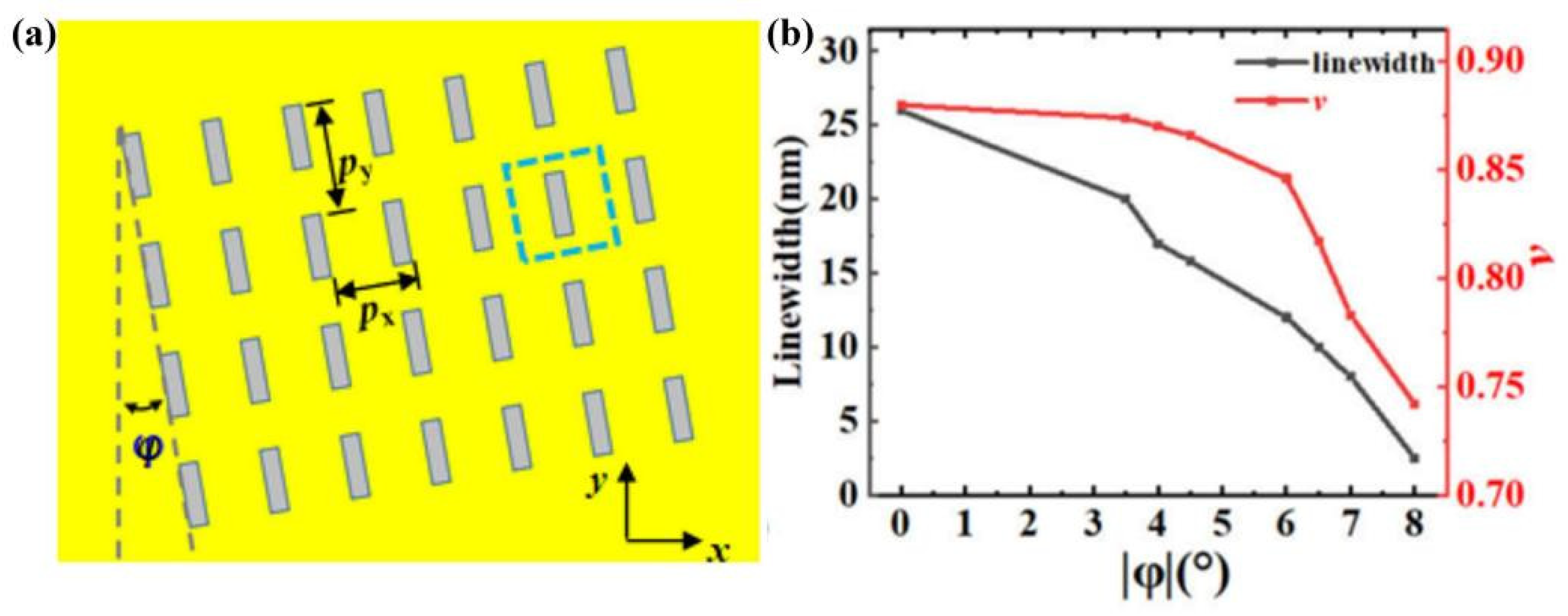
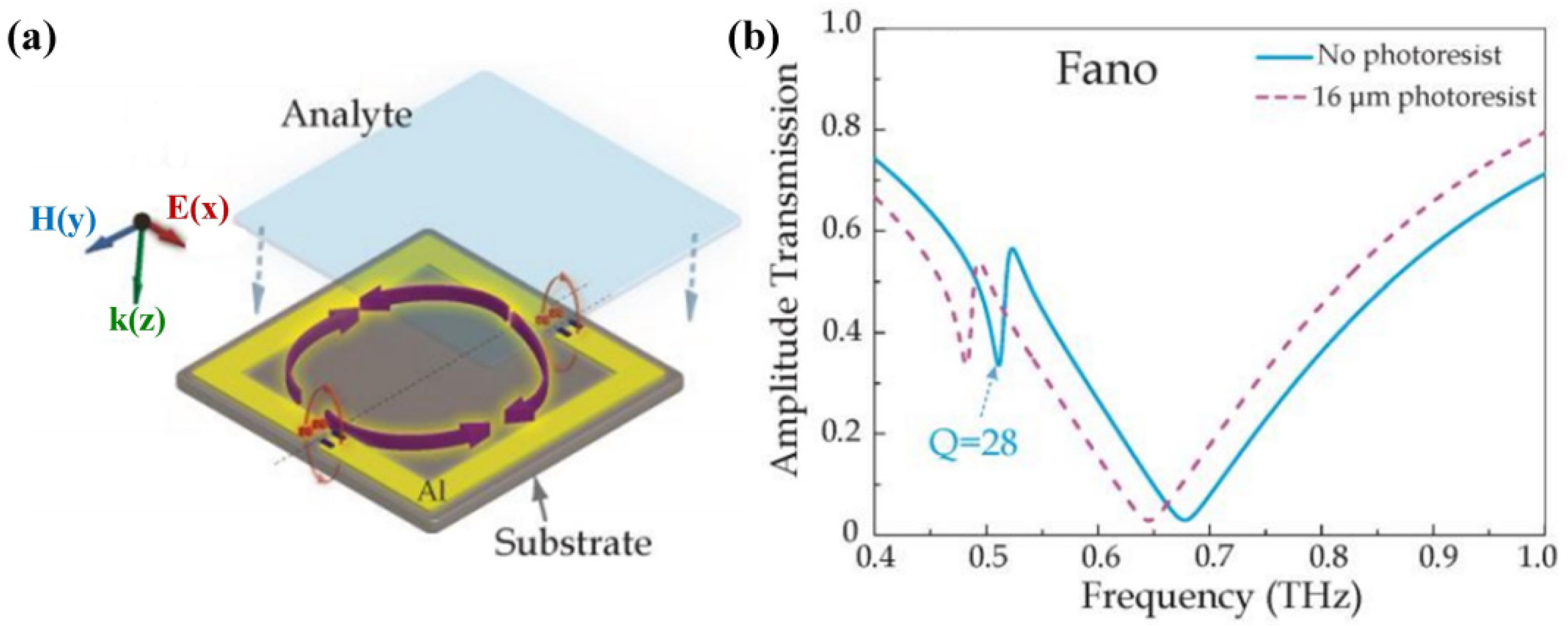
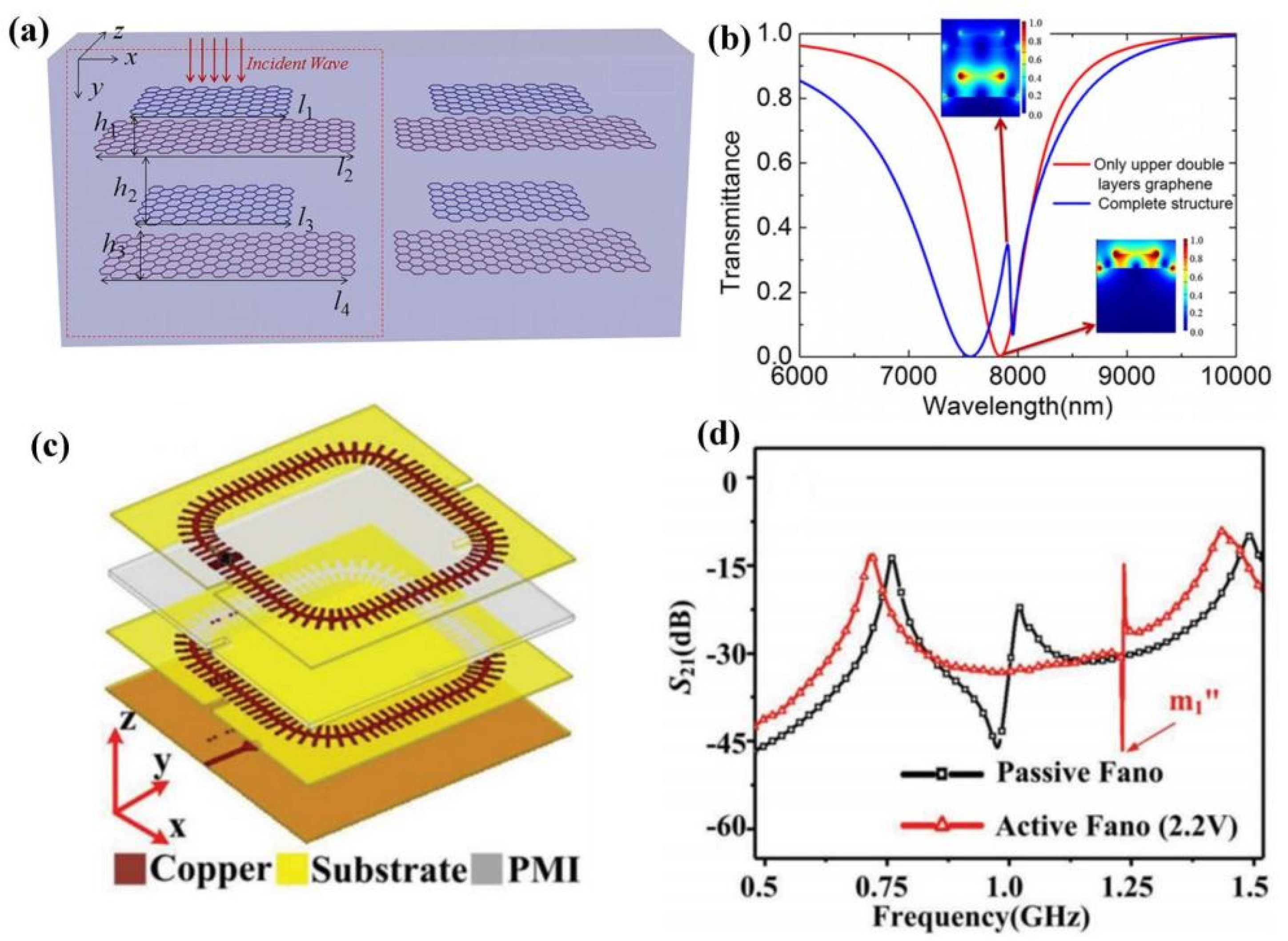
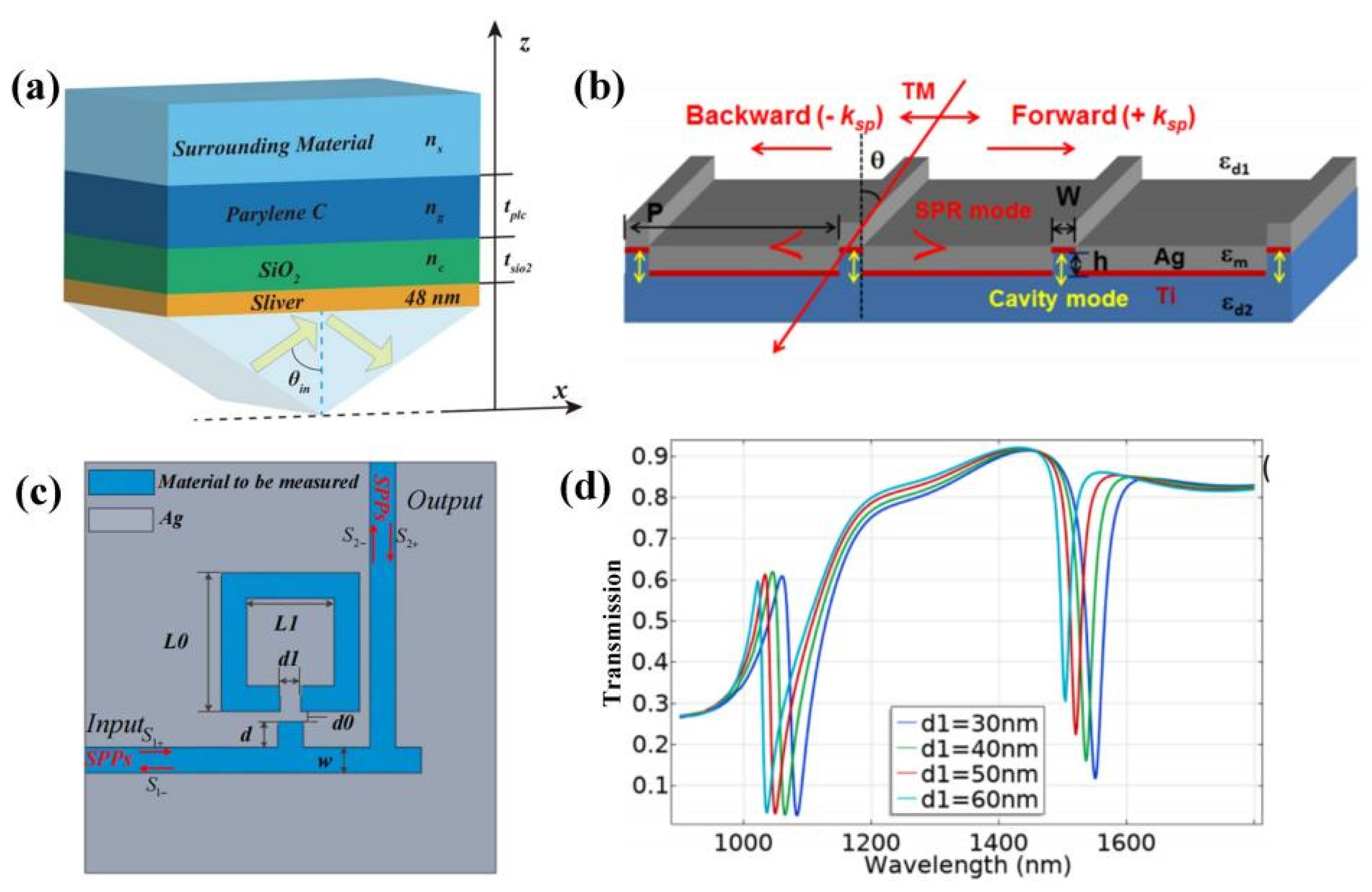

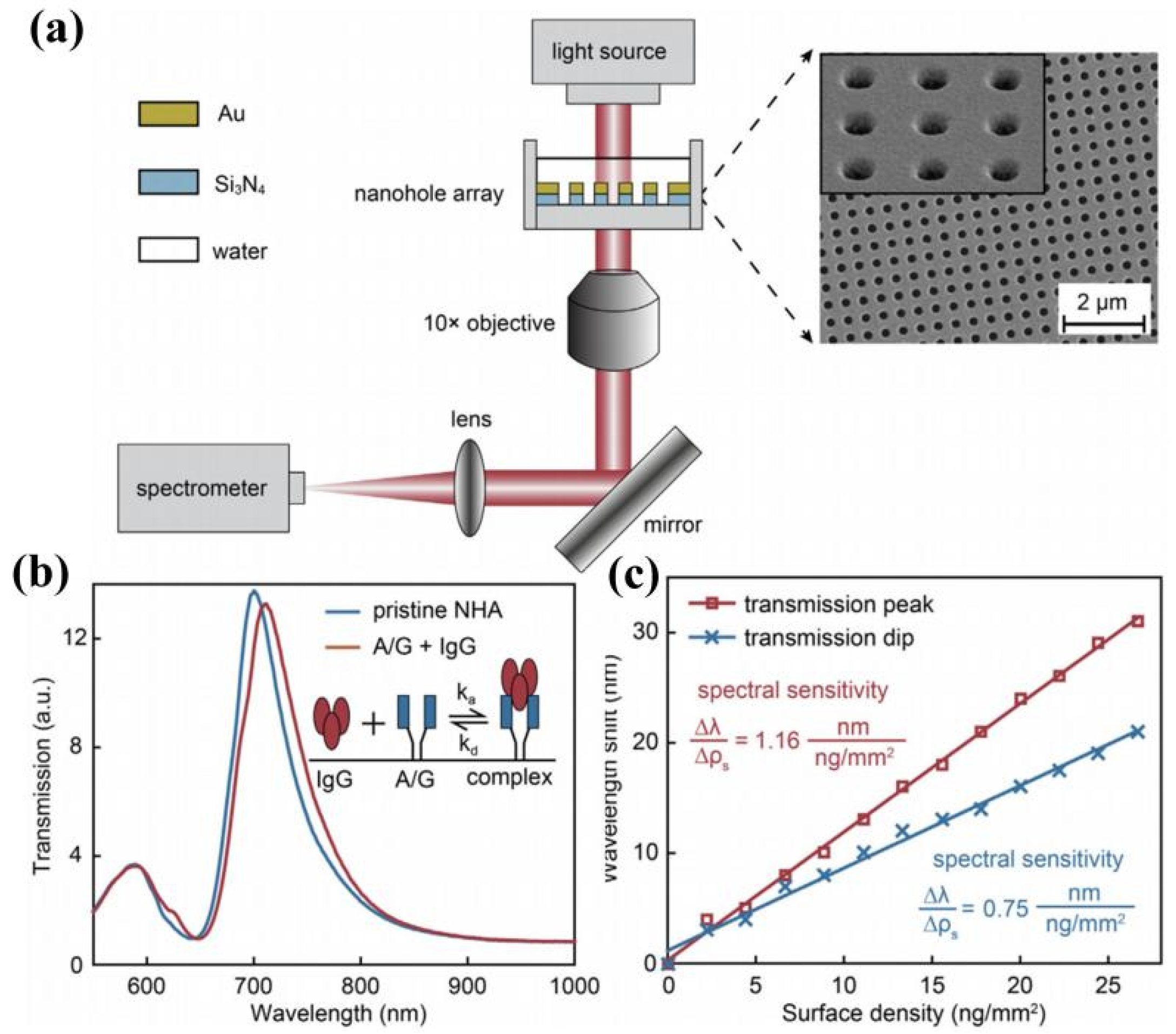
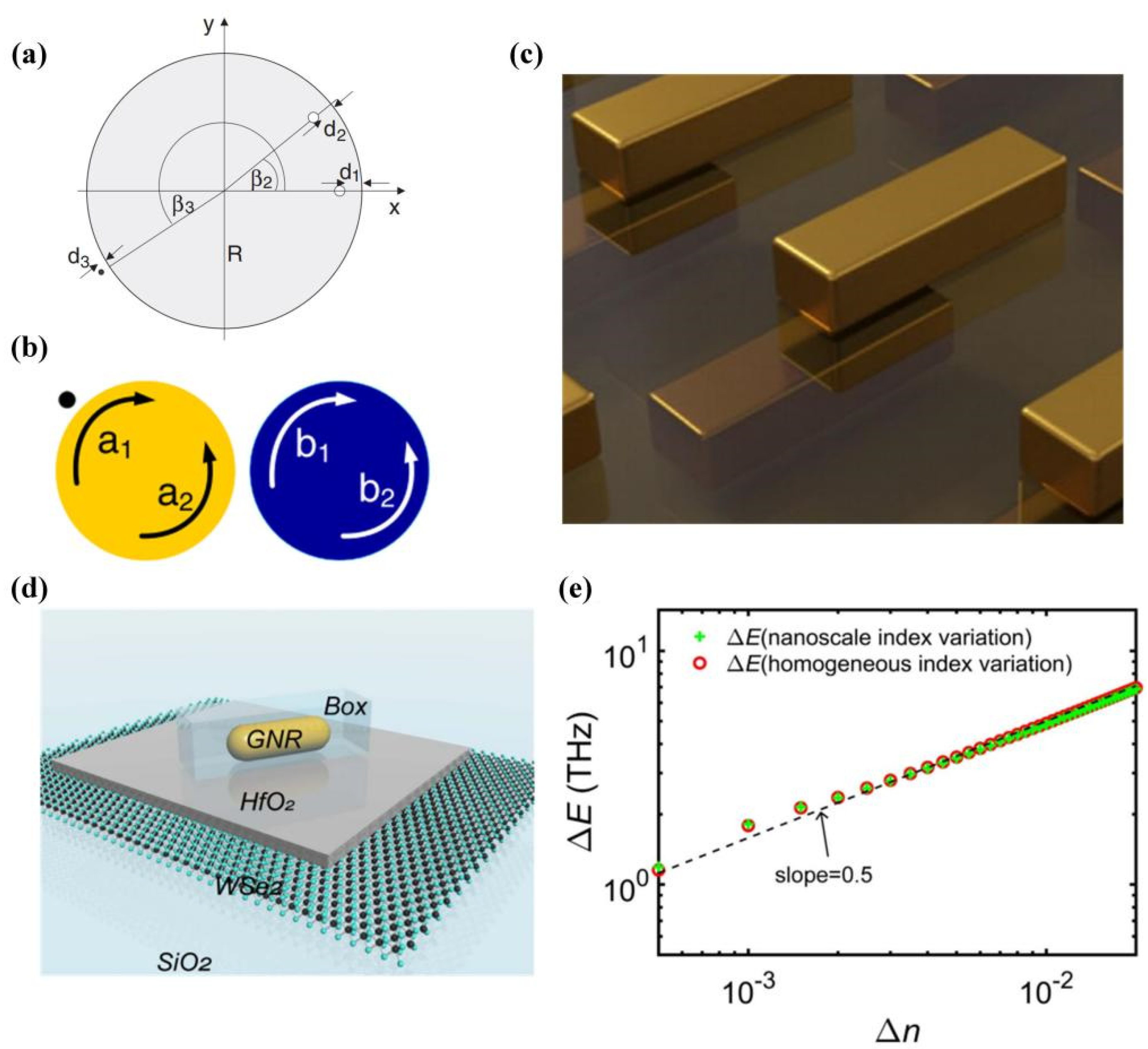
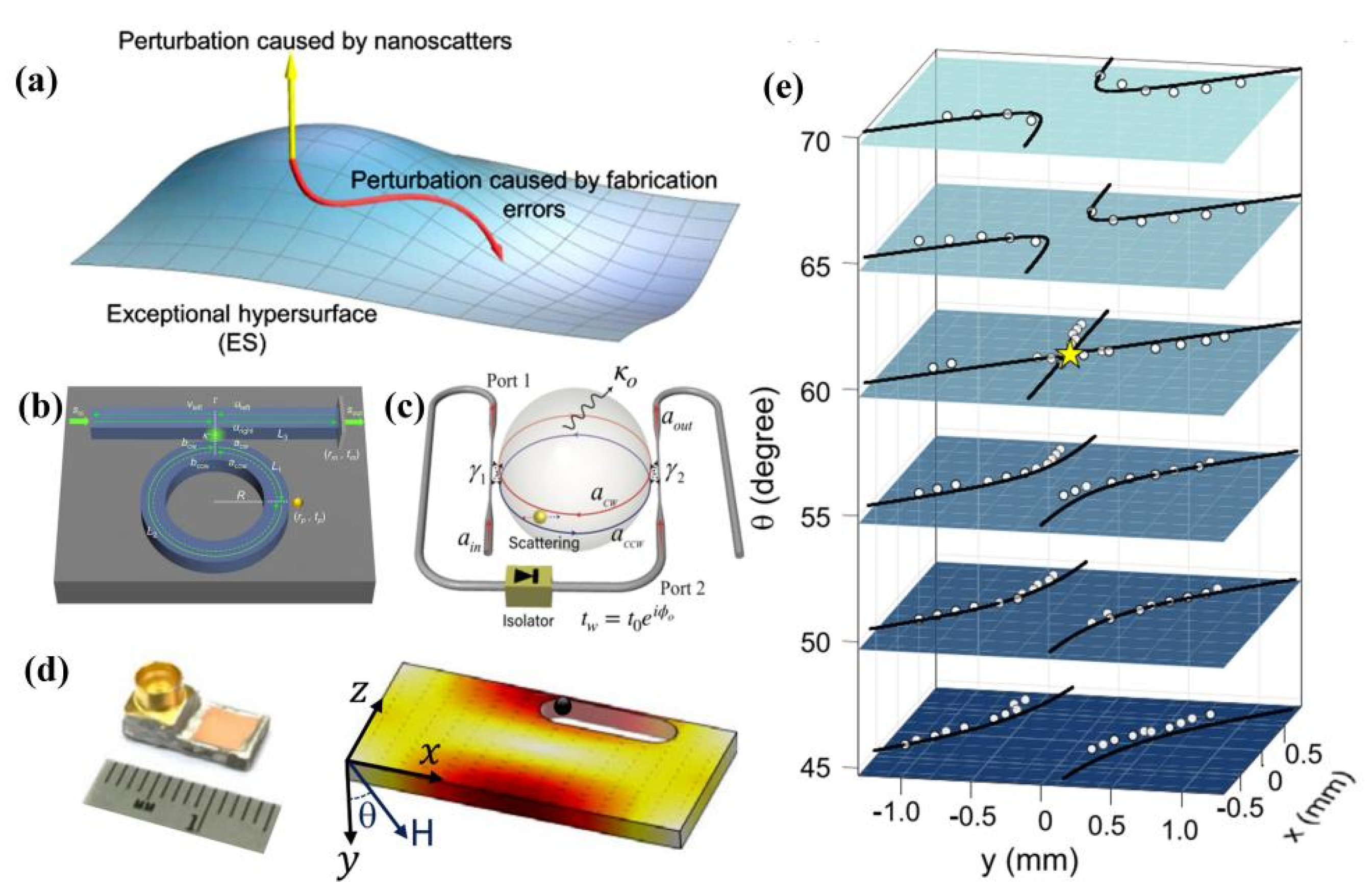
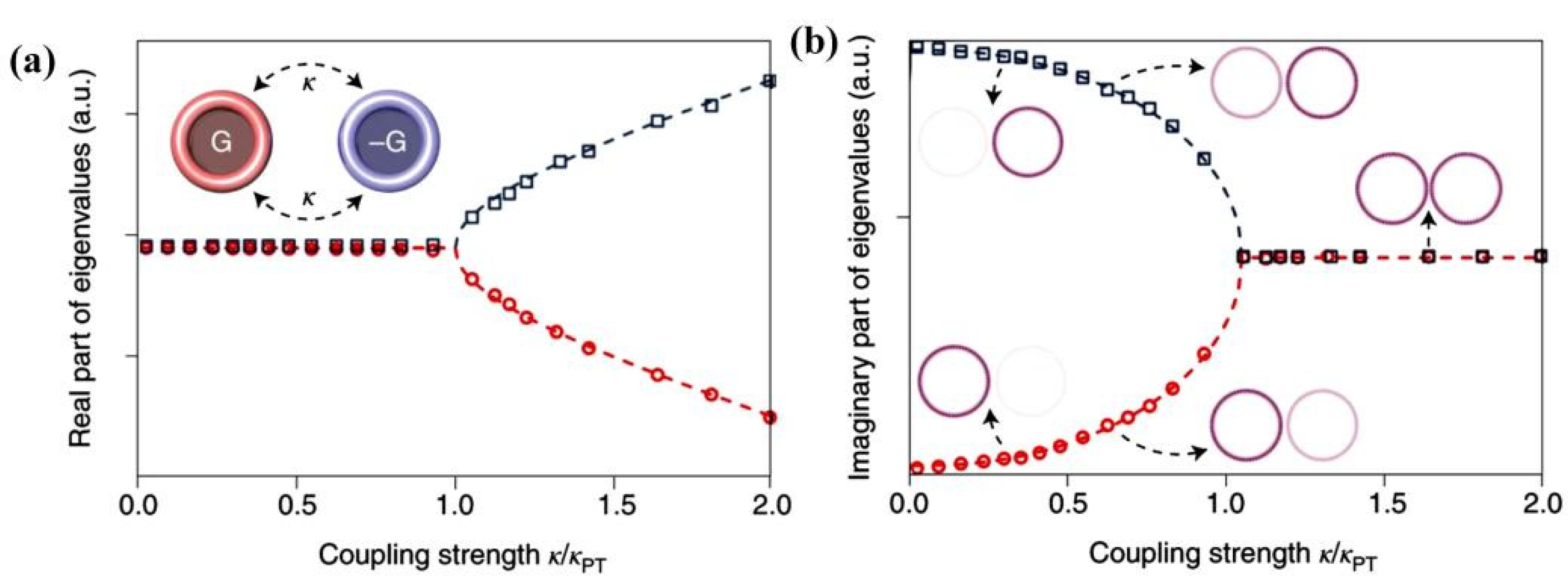
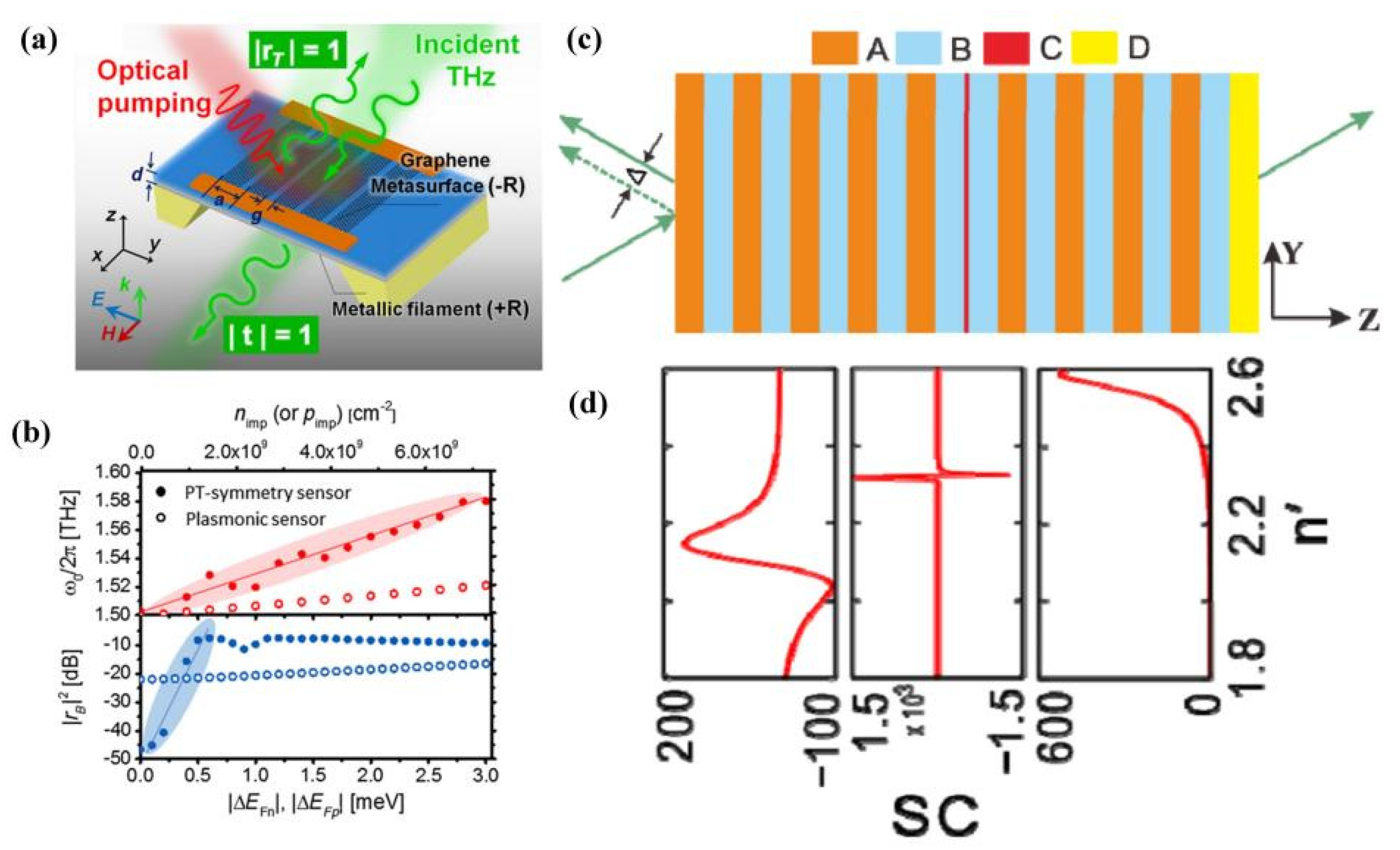

| Structure | Analyte | Sensitivity | Q | FOM | Year | Ref. |
|---|---|---|---|---|---|---|
| Split ring–perfect ring | Dielectric material | 1225 nm/RIU | – | 30.4 | 2015 | [64] |
| Antisymmetric eight–member nanoshell oligomer | Mixed liquids | – | – | 22.5 | 2015 | [67] |
| Metal nano–groove array | NaCl solution | 657 nm/RIU | – | 263 | 2021 | [70] |
| L–nanoarray | Dielectric material | 1360 nm/RIU | – | 29 | 2018 | [71] |
| Double two–split nanorings | Healthy and cancerous tissues | 594 nm/RIU | 566 | 378 | 2019 | [72] |
| Asymmetrical split–resonance rings | – | – | 394.5 | 371.9 | 2015 | [88] |
| Active split–ring resonators based on graphene | Analyte coated | 1.87021 THz/RIU | – | – | 2016 | [90] |
| Multilayer graphene | Analyte coated | 7885 nm/RIU | – | 9786 | 2018 | [91] |
| Metal grating array | BSA and anti–BSA | 460 nm/RIU | – | 58 | 2019 | [100] |
| MIM | Glucose solution | 1300 nm/RIU | 39.38 | 29.55 | 2022 | [109] |
| Load the partially reflected microloop | Glucose solution | 0.024% or 24 n g/dL | – | – | 2003 | [111] |
| Waveguide coupled with a microring resonator | K+ ions density of KxMoO3 | 154.3 nm/RIU | – | – | 2021 | [112] |
| Embedded–ring resonators | Mixed liquids | 1.21 × 104 nm/RIU | – | – | 2014 | [113] |
| Splitting ring array | Analyte coated | 7.75 × 103 nm/RIU | 28 | – | 2014 | [123] |
| Plasmonic nanohole array | Monolayer of protein | ~53 nm/RIU | – | – | 2020 | [127] |
| Nanohole array | NaCl solutions | 690.12 nm/RIU | 200 | 162 | 2011 | [128] |
| Nanorods in nanopore arrays | – | 1200.6 nm/RIU | – | 279.2 | 2022 | [129] |
| Broken ring array | Analyte coated | 2.06 × 104 nm/RIU | 38 | – | 2015 | [131] |
| Asymmetric split–ring resonator | Analyte coated | 7.32 × 104 nm/RIU | 9.6 | – | 2017 | [132] |
| Structure | Analyte | Sensitivity | Year | Ref. |
|---|---|---|---|---|
| Optical tunneling effect resonator | Carcinoembryonic antigen | 17,120 nm/IP | 2022 | [49] |
| Plasmon–exciton system | RI of gold nanorod | 100 THz/RIU | 2022 | [50] |
| Active graphene metasurface | Density of charged impurities | 1.15 GHz/um2 | 2016 | [142] |
| Bilayer periodic plasmonic structure | RI coating | 671 nm/RIU | 2020 | [147] |
| Optical gyroscope | Angular velocity | 0.1–100°/h | 2017 | [160] |
| PT–symmetrically coupled microdisk | RI of cavity | 83 nm/RIU | 2015 | [161] |
Publisher’s Note: MDPI stays neutral with regard to jurisdictional claims in published maps and institutional affiliations. |
© 2022 by the authors. Licensee MDPI, Basel, Switzerland. This article is an open access article distributed under the terms and conditions of the Creative Commons Attribution (CC BY) license (https://creativecommons.org/licenses/by/4.0/).
Share and Cite
Li, Q.; Wu, X.; Zhou, Y. Plasmonic Nanosensors and Metasensors Based on New Physical Mechanisms. Chemosensors 2022, 10, 397. https://doi.org/10.3390/chemosensors10100397
Li Q, Wu X, Zhou Y. Plasmonic Nanosensors and Metasensors Based on New Physical Mechanisms. Chemosensors. 2022; 10(10):397. https://doi.org/10.3390/chemosensors10100397
Chicago/Turabian StyleLi, Qiaoyu, Xiongbin Wu, and Yongjin Zhou. 2022. "Plasmonic Nanosensors and Metasensors Based on New Physical Mechanisms" Chemosensors 10, no. 10: 397. https://doi.org/10.3390/chemosensors10100397
APA StyleLi, Q., Wu, X., & Zhou, Y. (2022). Plasmonic Nanosensors and Metasensors Based on New Physical Mechanisms. Chemosensors, 10(10), 397. https://doi.org/10.3390/chemosensors10100397






